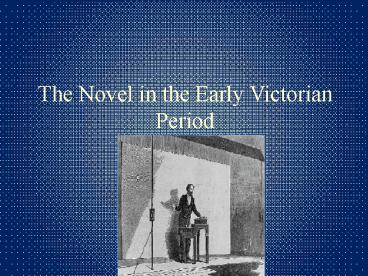The Novel in the Early Victorian Period - PowerPoint PPT Presentation
1 / 12
Title:
The Novel in the Early Victorian Period
Description:
The Novel in the Early Victorian Period Queen Victoria 1837-1901 Some characteristics of the age An unprecedented rate of industrialisation and its discontents ... – PowerPoint PPT presentation
Number of Views:152
Avg rating:3.0/5.0
Title: The Novel in the Early Victorian Period
1
The Novel in the Early Victorian Period
2
Queen Victoria 1837-1901
3
Some characteristics of the age
- An unprecedented rate of industrialisation and
its discontents - Imperial expansion
- Demographic boom
- Social reform and labour struggles Chartism
- Debates on the nature of culture, society, morals
- Advances in science and medicine
- Religious revivalism and crises
- Pruderie, decorum, respectability the Victorian
Compromise
4
Crystal Palace, the site of the Great Exibition
of 1851
5
Genral features of the novel
- The representative, but still developing, genre
- Expanding, predominantly middle-class, readership
- Modes of production and consumption influenced
its form - Entertainment, didactic purposes, propaganda,
discussion - A unique relationship to the reading public
- The condition of England
6
The Condition of England
- Thomas Carlyle (1795-1881) Past and Present 1843
(N.B. not a novel) - From ch.13, Democracy
- And yet I will venture to believe that in no
time, since the beginnings of Society, was the
lot of those same dumb millions of toilers so
entirely unbearable as it is even in the days now
passing over us. It is not to die, or even to die
of hunger, that makes a man wretched many men
have died all men must die,--the last exit of us
all is in a Fire-Chariot of Pain. But it is to
live miserable we know not why to work sore and
yet gain nothing to be heart-worn, weary, yet
isolated, unrelated, girt in with a cold
universal Laissez-faire it is to die slowly all
our life long, imprisoned in a deaf, dead,
Infinite Injustice, as in the accursed iron belly
of a Phalaris' Bull! This is and remains forever
intolerable to all men whom God has made. Do we
wonder at French Revolutions, Chartisms, Revolts
of Three Days? The times, if we will consider
them,are really unexampled. - Friedrich Engels (1820-1895) Die Lage der
arbeitenden Klasse in England, 1844 - Benjamin Disraeli (1804-1881) Sybil, or The Two
Nations 1845
7
The principal novelists and their representative
works
- Charles Dickens (1812-1870)
- The Pickwick Papers March 1836-October 1837
- Oliver Twist February 1837-April 1838
- Martin Chuzzlewit 1843-1844
- David Copperfield 1849-1850
- Bleak House 1852-1853
- Hard Times 1854
- Little Dorrit 1855-1857
- Great Expectations 1860-1861
- Our Mutual Friend 1864-1865
8
The principal novelists and their representative
works
- William Makepeace Thackeray (1811-1863)
- The Luck of Barry Lyndon 1844
- The Book of Snobs 1848
- The History of Henry Esmond 1852
- Vanity Fair 1848
9
The principal novelists and their representative
works
- Charlotte Brontë (1816-55)
- Jane Eyre An Autobiography 1847
- Shirley 1849
- Villette 1853
- Anne Brontë (1820-49)
- Agnes Grey 1847
- The Tenant of Wildfell Hall 1848
- Emily Brontë (1818-1848)
- Wuthering Heights 1847
10
Anne, Emily and Charlotte Brontë, painted by
their brother Branwell c. 1834
11
The principal novelists and their representative
works
- Elizabeth Gaskell (1810-65)
- Mary Barton 1848
- North and South 1854-1855
- The Life of Charlotte Brontë 1857 a
- biography
- Cranford 1851-53
- Wives and Daughters 1865
12
The principal novelists and their representative
works
- Anthony Trollope (1815-82)
- Two cycles the Barsetshire Chronicles
(1847-67) and the Palisser series (1864-80) - The Way We Live Now 1874-1875































